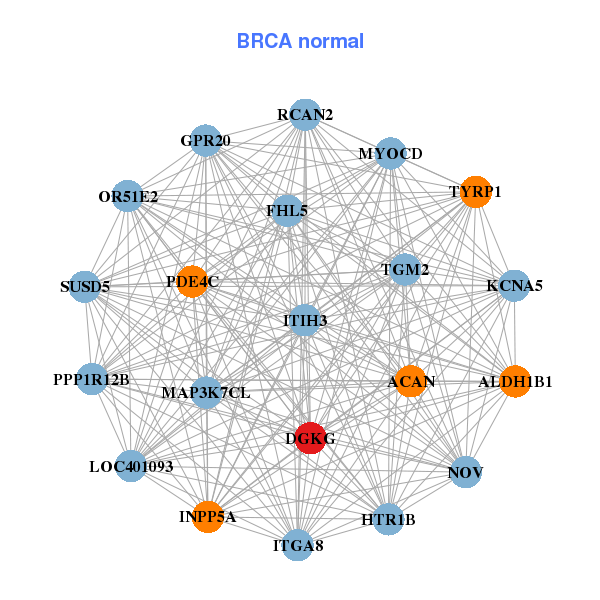|
||||||||||||||||||||||||||||||||||||||||||||||||||||||||||||||||||||||||||||||||||||||||||||||||||||||||||||||||||||||||||||||||||||||||||||||||||||||||||||||||||||||||||||||||||||||||||||||||||||||||||||||||||||||||||||||||||||||||||||||||||||||||||||||||||||||||||||||||||||||||||||||||||||||||||||||||||||||||||||||||||||||||||||||||||||||
| |
| Phenotypic Information (metabolism pathway, cancer, disease, phenome) |
| |
| |
| Gene-Gene Network Information: Co-Expression Network, Interacting Genes & KEGG |
| |
|
| Gene Summary for DGKG |
| Basic gene info. | Gene symbol | DGKG |
| Gene name | diacylglycerol kinase, gamma 90kDa | |
| Synonyms | DAGK3|DGK-GAMMA | |
| Cytomap | UCSC genome browser: 3q27.2-q27.3 | |
| Genomic location | chr3 :185864989-186080023 | |
| Type of gene | protein-coding | |
| RefGenes | NM_001080744.1, NM_001080745.1,NM_001346.2, | |
| Ensembl id | ENSG00000058866 | |
| Description | DAG kinase gammadiacylglycerol kinase gammadiacylglyerol kinase gammadiglyceride kinase gamma | |
| Modification date | 20141207 | |
| dbXrefs | MIM : 601854 | |
| HGNC : HGNC | ||
| Ensembl : ENSG00000058866 | ||
| HPRD : 03510 | ||
| Vega : OTTHUMG00000156617 | ||
| Protein | UniProt: P49619 go to UniProt's Cross Reference DB Table | |
| Expression | CleanEX: HS_DGKG | |
| BioGPS: 1608 | ||
| Gene Expression Atlas: ENSG00000058866 | ||
| The Human Protein Atlas: ENSG00000058866 | ||
| Pathway | NCI Pathway Interaction Database: DGKG | |
| KEGG: DGKG | ||
| REACTOME: DGKG | ||
| ConsensusPathDB | ||
| Pathway Commons: DGKG | ||
| Metabolism | MetaCyc: DGKG | |
| HUMANCyc: DGKG | ||
| Regulation | Ensembl's Regulation: ENSG00000058866 | |
| miRBase: chr3 :185,864,989-186,080,023 | ||
| TargetScan: NM_001080744 | ||
| cisRED: ENSG00000058866 | ||
| Context | iHOP: DGKG | |
| cancer metabolism search in PubMed: DGKG | ||
| UCL Cancer Institute: DGKG | ||
| Assigned class in ccmGDB | A - This gene has a literature evidence and it belongs to cancer gene. | |
| References showing role of DGKG in cancer cell metabolism | 1. Vahtola E, Storvik M, Louhelainen M, Merasto S, Lakkisto P, et al. (2011) Effects of levosimendan on cardiac gene expression profile and post-infarct cardiac remodelling in diabetic Goto-Kakizaki rats. Basic Clin Pharmacol Toxicol 109: 387-397. doi: 10.1111/j.1742-7843.2011.00743.x. go to article | |
| Top |
| Phenotypic Information for DGKG(metabolism pathway, cancer, disease, phenome) |
| Cancer | CGAP: DGKG |
| Familial Cancer Database: DGKG | |
| * This gene is included in those cancer gene databases. |
|
|
|
|
|
| . | ||||||||||||||||||||||||||||||||||||||||||||||||||||||||||||||||||||||||||||||||||||||||||||||||||||||||||||||||||||||||||||||||||||||||||||||||||||||||||||||||||||||||||||||||||||||||||||||||||||||||||||||||||||||||||||||||||||||||||||||||||||||||||||||||||||||||||||||||||||||||||||||||||||||||||||||||||||||||||||||||||||||||||||||||
Oncogene 1 | Significant driver gene in BRCA 6, | |||||||||||||||||||||||||||||||||||||||||||||||||||||||||||||||||||||||||||||||||||||||||||||||||||||||||||||||||||||||||||||||||||||||||||||||||||||||||||||||||||||||||||||||||||||||||||||||||||||||||||||||||||||||||||||||||||||||||||||||||||||||||||||||||||||||||||||||||||||||||||||||||||||||||||||||||||||||||||||||||||||||||||||||||||||
| cf) number; DB name 1 Oncogene; http://nar.oxfordjournals.org/content/35/suppl_1/D721.long, 2 Tumor Suppressor gene; https://bioinfo.uth.edu/TSGene/, 3 Cancer Gene Census; http://www.nature.com/nrc/journal/v4/n3/abs/nrc1299.html, 4 CancerGenes; http://nar.oxfordjournals.org/content/35/suppl_1/D721.long, 5 Network of Cancer Gene; http://ncg.kcl.ac.uk/index.php, 6 http://www.nature.com/nature/journal/v490/n7418/full/nature11412.html, 7Therapeutic Vulnerabilities in Cancer; http://cbio.mskcc.org/cancergenomics/statius/ |
| KEGG_GLYCEROLIPID_METABOLISM KEGG_GLYCEROPHOSPHOLIPID_METABOLISM | |
| OMIM | 601854; gene. |
| Orphanet | |
| Disease | KEGG Disease: DGKG |
| MedGen: DGKG (Human Medical Genetics with Condition) | |
| ClinVar: DGKG | |
| Phenotype | MGI: DGKG (International Mouse Phenotyping Consortium) |
| PhenomicDB: DGKG | |
| Mutations for DGKG |
| * Under tables are showing count per each tissue to give us broad intuition about tissue specific mutation patterns.You can go to the detailed page for each mutation database's web site. |
| - Statistics for Tissue and Mutation type | Top |
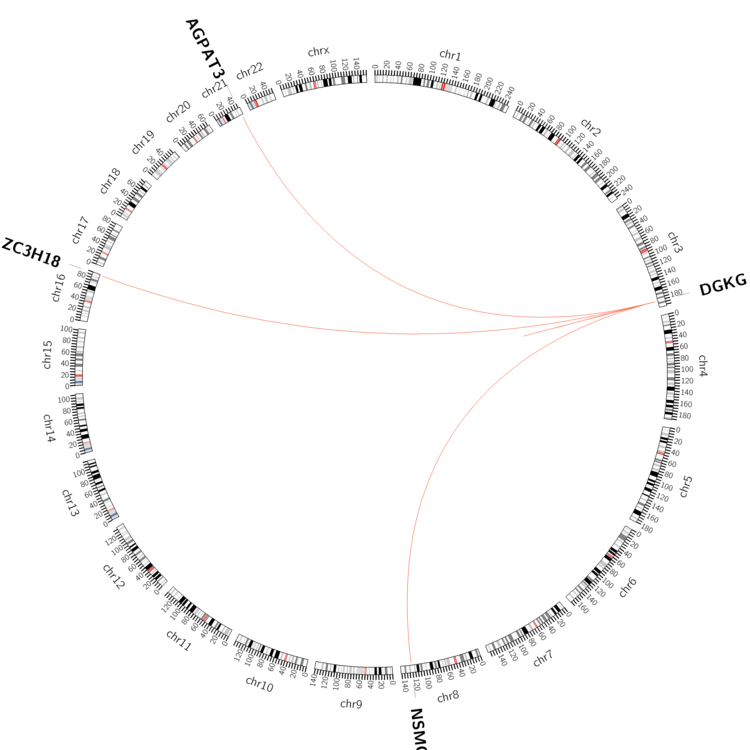 |
| - For Inter-chromosomal Variations |
| * Inter-chromosomal variantions includes 'interchromosomal amplicon to amplicon', 'interchromosomal amplicon to non-amplified dna', 'interchromosomal insertion', 'Interchromosomal unknown type'. |
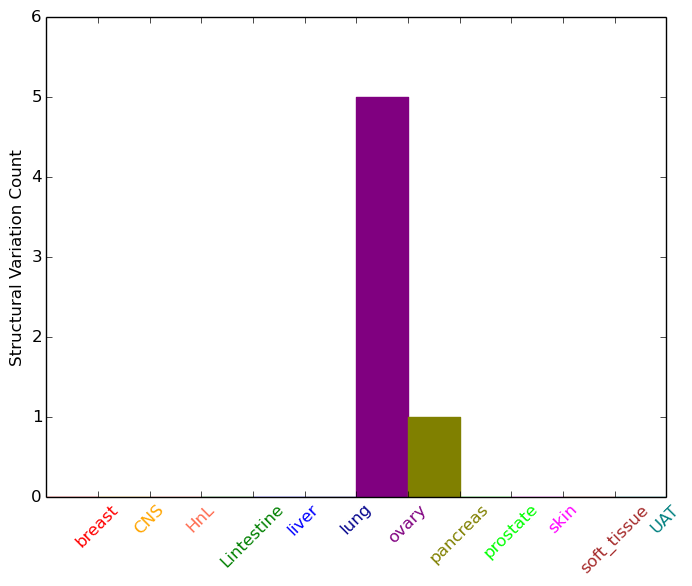 |
| - For Intra-chromosomal Variations |
| * Intra-chromosomal variantions includes 'intrachromosomal amplicon to amplicon', 'intrachromosomal amplicon to non-amplified dna', 'intrachromosomal deletion', 'intrachromosomal fold-back inversion', 'intrachromosomal inversion', 'intrachromosomal tandem duplication', 'Intrachromosomal unknown type', 'intrachromosomal with inverted orientation', 'intrachromosomal with non-inverted orientation'. |
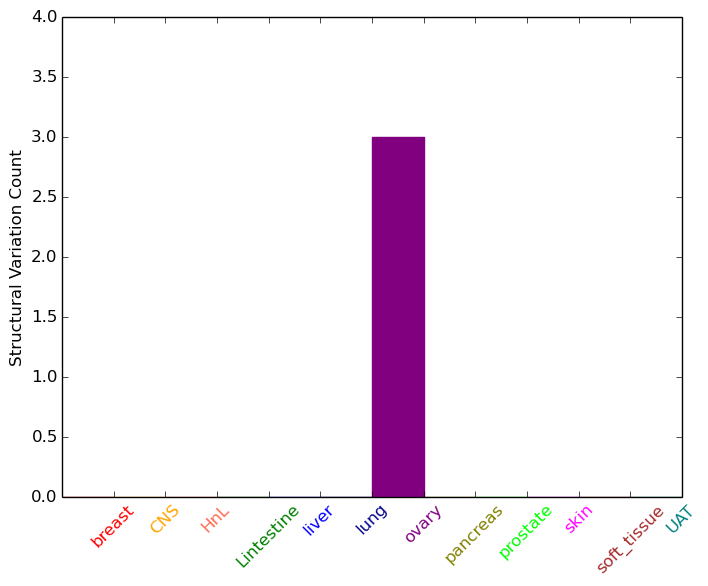 |
| Sample | Symbol_a | Chr_a | Start_a | End_a | Symbol_b | Chr_b | Start_b | End_b |
| ovary | DGKG | chr3 | 185870654 | 185870674 | chr3 | 186094451 | 186094471 | |
| ovary | DGKG | chr3 | 185903150 | 185903170 | DGKG | chr3 | 185899362 | 185899382 |
| ovary | DGKG | chr3 | 185947388 | 185947408 | ZC3H18 | chr16 | 88644360 | 88644380 |
| ovary | DGKG | chr3 | 186040698 | 186040718 | DGKG | chr3 | 186039491 | 186039511 |
| ovary | DGKG | chr3 | 186068824 | 186068844 | NSMCE2 | chr8 | 126267459 | 126267479 |
| pancreas | DGKG | chr3 | 185960886 | 185960906 | AGPAT3 | chr21 | 45356569 | 45356589 |
| cf) Tissue number; Tissue name (1;Breast, 2;Central_nervous_system, 3;Haematopoietic_and_lymphoid_tissue, 4;Large_intestine, 5;Liver, 6;Lung, 7;Ovary, 8;Pancreas, 9;Prostate, 10;Skin, 11;Soft_tissue, 12;Upper_aerodigestive_tract) |
| * From mRNA Sanger sequences, Chitars2.0 arranged chimeric transcripts. This table shows DGKG related fusion information. |
| ID | Head Gene | Tail Gene | Accession | Gene_a | qStart_a | qEnd_a | Chromosome_a | tStart_a | tEnd_a | Gene_a | qStart_a | qEnd_a | Chromosome_a | tStart_a | tEnd_a |
| BF921517 | DGKG | 28 | 312 | 3 | 185996755 | 185997040 | PCDH9 | 308 | 480 | 13 | 67661420 | 67661592 | |
| AA322377 | FAM107B | 177 | 211 | 10 | 14716854 | 14717034 | DGKG | 204 | 277 | 3 | 185969588 | 185969661 | |
| BI020438 | DGKG | 2 | 278 | 3 | 185905959 | 185906234 | RUNX1 | 272 | 423 | 21 | 36289624 | 36289775 | |
| BF732626 | GRINA | 1 | 220 | 8 | 145064317 | 145065536 | DGKG | 216 | 517 | 3 | 185910768 | 185911069 | |
| BF902754 | DGKG | 1 | 83 | 3 | 185882770 | 185906035 | TECPR2 | 78 | 248 | 14 | 102846004 | 102846174 | |
| Top |
| Mutation type/ Tissue ID | brca | cns | cerv | endome | haematopo | kidn | Lintest | liver | lung | ns | ovary | pancre | prost | skin | stoma | thyro | urina | |||
| Total # sample | 5 | 1 | 7 | |||||||||||||||||
| GAIN (# sample) | 4 | 1 | 7 | |||||||||||||||||
| LOSS (# sample) | 1 |
| cf) Tissue ID; Tissue type (1; Breast, 2; Central_nervous_system, 3; Cervix, 4; Endometrium, 5; Haematopoietic_and_lymphoid_tissue, 6; Kidney, 7; Large_intestine, 8; Liver, 9; Lung, 10; NS, 11; Ovary, 12; Pancreas, 13; Prostate, 14; Skin, 15; Stomach, 16; Thyroid, 17; Urinary_tract) |
| Top |
|
 |
| Top |
| Stat. for Non-Synonymous SNVs (# total SNVs=84) | (# total SNVs=26) |
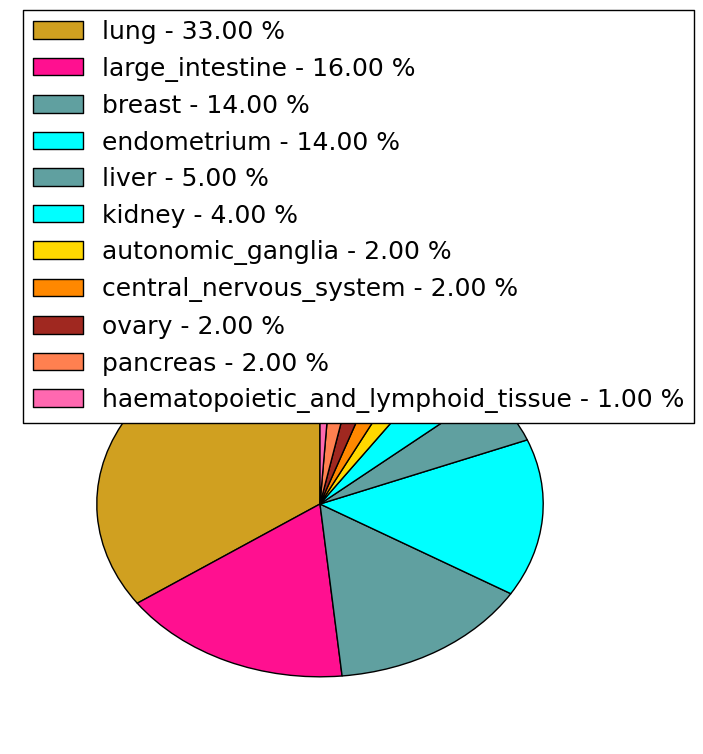 | 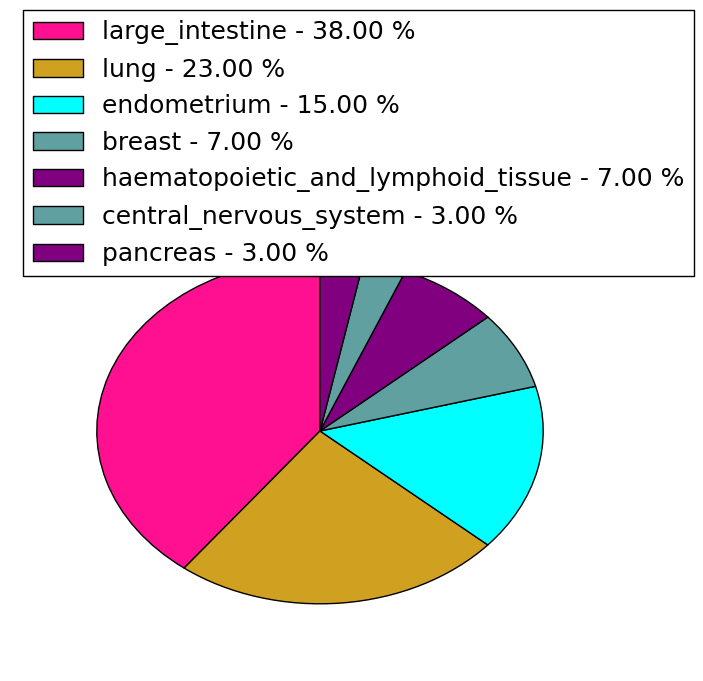 |
(# total SNVs=0) | (# total SNVs=0) |
| Top |
| * When you move the cursor on each content, you can see more deailed mutation information on the Tooltip. Those are primary_site,primary_histology,mutation(aa),pubmedID. |
| GRCh37 position | Mutation(aa) | Unique sampleID count |
| chr3:185986591-185986591 | p.T372M | 2 |
| chr3:185867951-185867951 | p.A768A | 2 |
| chr3:185970917-185970917 | p.G522E | 2 |
| chr3:186006602-186006602 | p.V148fs*14 | 2 |
| chr3:186015888-186015888 | p.T92M | 2 |
| chr3:186024722-186024722 | p.G38S | 2 |
| chr3:185986618-185986618 | p.A363V | 2 |
| chr3:185882787-185882787 | p.E706K | 2 |
| chr3:185969700-185969700 | p.G537W | 2 |
| chr3:186015231-186015231 | p.E118K | 2 |
| Top |
|
 |
| Point Mutation/ Tissue ID | 1 | 2 | 3 | 4 | 5 | 6 | 7 | 8 | 9 | 10 | 11 | 12 | 13 | 14 | 15 | 16 | 17 | 18 | 19 | 20 |
| # sample | 6 | 7 | 9 | 2 | 3 | 2 | 1 | 14 | 5 | 20 | 3 | 12 | ||||||||
| # mutation | 6 | 6 | 10 | 2 | 3 | 2 | 1 | 16 | 5 | 22 | 3 | 14 | ||||||||
| nonsynonymous SNV | 4 | 4 | 4 | 2 | 2 | 1 | 15 | 4 | 16 | 2 | 10 | |||||||||
| synonymous SNV | 2 | 2 | 6 | 3 | 1 | 1 | 6 | 1 | 4 |
| cf) Tissue ID; Tissue type (1; BLCA[Bladder Urothelial Carcinoma], 2; BRCA[Breast invasive carcinoma], 3; CESC[Cervical squamous cell carcinoma and endocervical adenocarcinoma], 4; COAD[Colon adenocarcinoma], 5; GBM[Glioblastoma multiforme], 6; Glioma Low Grade, 7; HNSC[Head and Neck squamous cell carcinoma], 8; KICH[Kidney Chromophobe], 9; KIRC[Kidney renal clear cell carcinoma], 10; KIRP[Kidney renal papillary cell carcinoma], 11; LAML[Acute Myeloid Leukemia], 12; LUAD[Lung adenocarcinoma], 13; LUSC[Lung squamous cell carcinoma], 14; OV[Ovarian serous cystadenocarcinoma ], 15; PAAD[Pancreatic adenocarcinoma], 16; PRAD[Prostate adenocarcinoma], 17; SKCM[Skin Cutaneous Melanoma], 18:STAD[Stomach adenocarcinoma], 19:THCA[Thyroid carcinoma], 20:UCEC[Uterine Corpus Endometrial Carcinoma]) |
| Top |
| * We represented just top 10 SNVs. When you move the cursor on each content, you can see more deailed mutation information on the Tooltip. Those are primary_site, primary_histology, mutation(aa), pubmedID. |
| Genomic Position | Mutation(aa) | Unique sampleID count |
| chr3:186006591 | p.T372M,DGKG | 2 |
| chr3:186006599 | p.E118K,DGKG | 2 |
| chr3:186015231 | p.A743A,DGKG | 2 |
| chr3:185986591 | p.S151F,DGKG | 2 |
| chr3:185867951 | p.V148V,DGKG | 2 |
| chr3:185879404 | p.D345N,DGKG | 1 |
| chr3:185983091 | p.V295I,DGKG | 1 |
| chr3:185986640 | p.P147L,DGKG | 1 |
| chr3:186015891 | p.G38G,DGKG | 1 |
| chr3:185906104 | p.A709T,DGKG | 1 |
| * Copy number data were extracted from TCGA using R package TCGA-Assembler. The URLs of all public data files on TCGA DCC data server were gathered on Jan-05-2015. Function ProcessCNAData in TCGA-Assembler package was used to obtain gene-level copy number value which is calculated as the average copy number of the genomic region of a gene. |
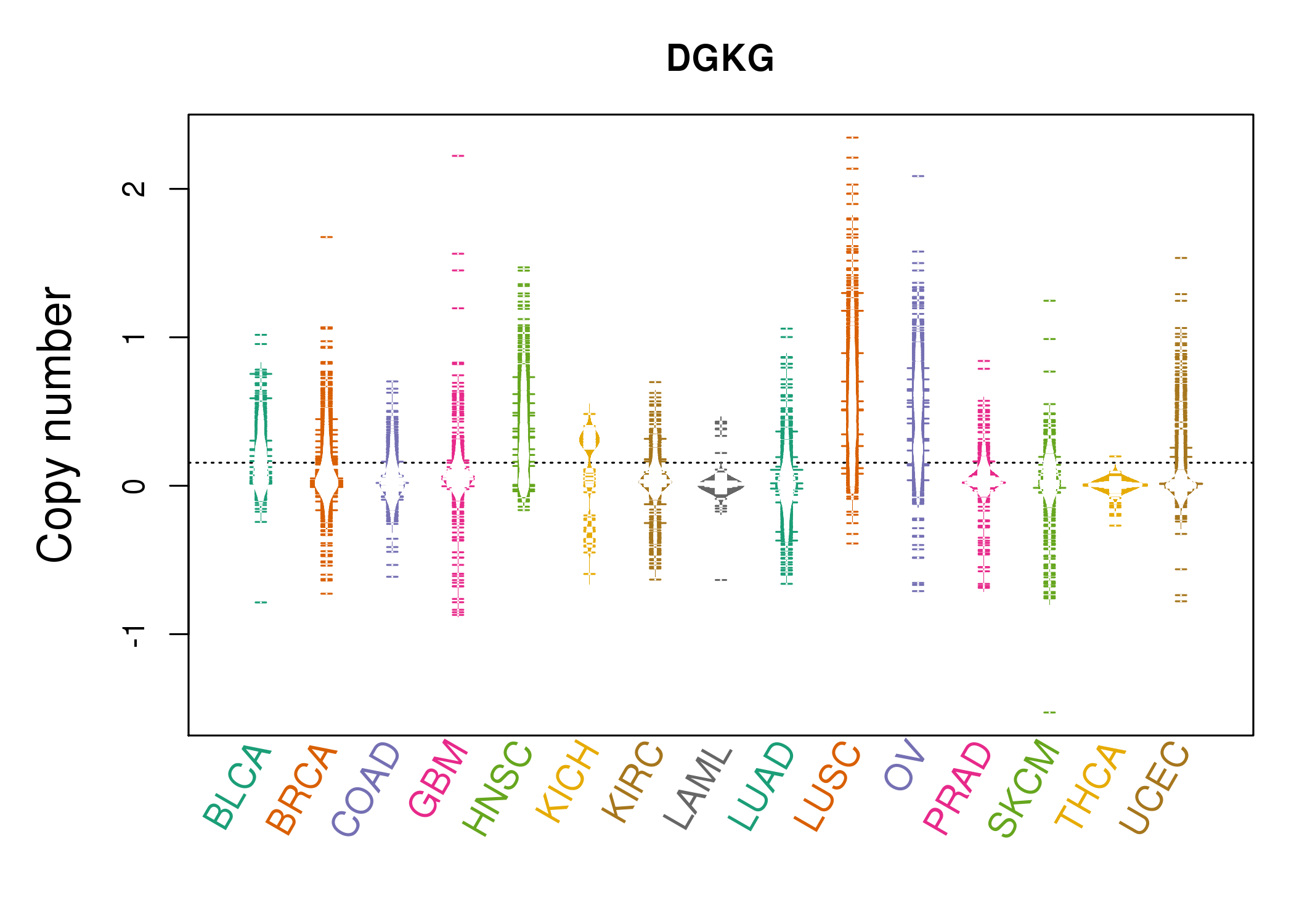 |
| cf) Tissue ID[Tissue type]: BLCA[Bladder Urothelial Carcinoma], BRCA[Breast invasive carcinoma], CESC[Cervical squamous cell carcinoma and endocervical adenocarcinoma], COAD[Colon adenocarcinoma], GBM[Glioblastoma multiforme], Glioma Low Grade, HNSC[Head and Neck squamous cell carcinoma], KICH[Kidney Chromophobe], KIRC[Kidney renal clear cell carcinoma], KIRP[Kidney renal papillary cell carcinoma], LAML[Acute Myeloid Leukemia], LUAD[Lung adenocarcinoma], LUSC[Lung squamous cell carcinoma], OV[Ovarian serous cystadenocarcinoma ], PAAD[Pancreatic adenocarcinoma], PRAD[Prostate adenocarcinoma], SKCM[Skin Cutaneous Melanoma], STAD[Stomach adenocarcinoma], THCA[Thyroid carcinoma], UCEC[Uterine Corpus Endometrial Carcinoma] |
| Top |
| Gene Expression for DGKG |
| * CCLE gene expression data were extracted from CCLE_Expression_Entrez_2012-10-18.res: Gene-centric RMA-normalized mRNA expression data. |
 |
| * Normalized gene expression data of RNASeqV2 was extracted from TCGA using R package TCGA-Assembler. The URLs of all public data files on TCGA DCC data server were gathered at Jan-05-2015. Only eight cancer types have enough normal control samples for differential expression analysis. (t test, adjusted p<0.05 (using Benjamini-Hochberg FDR)) |
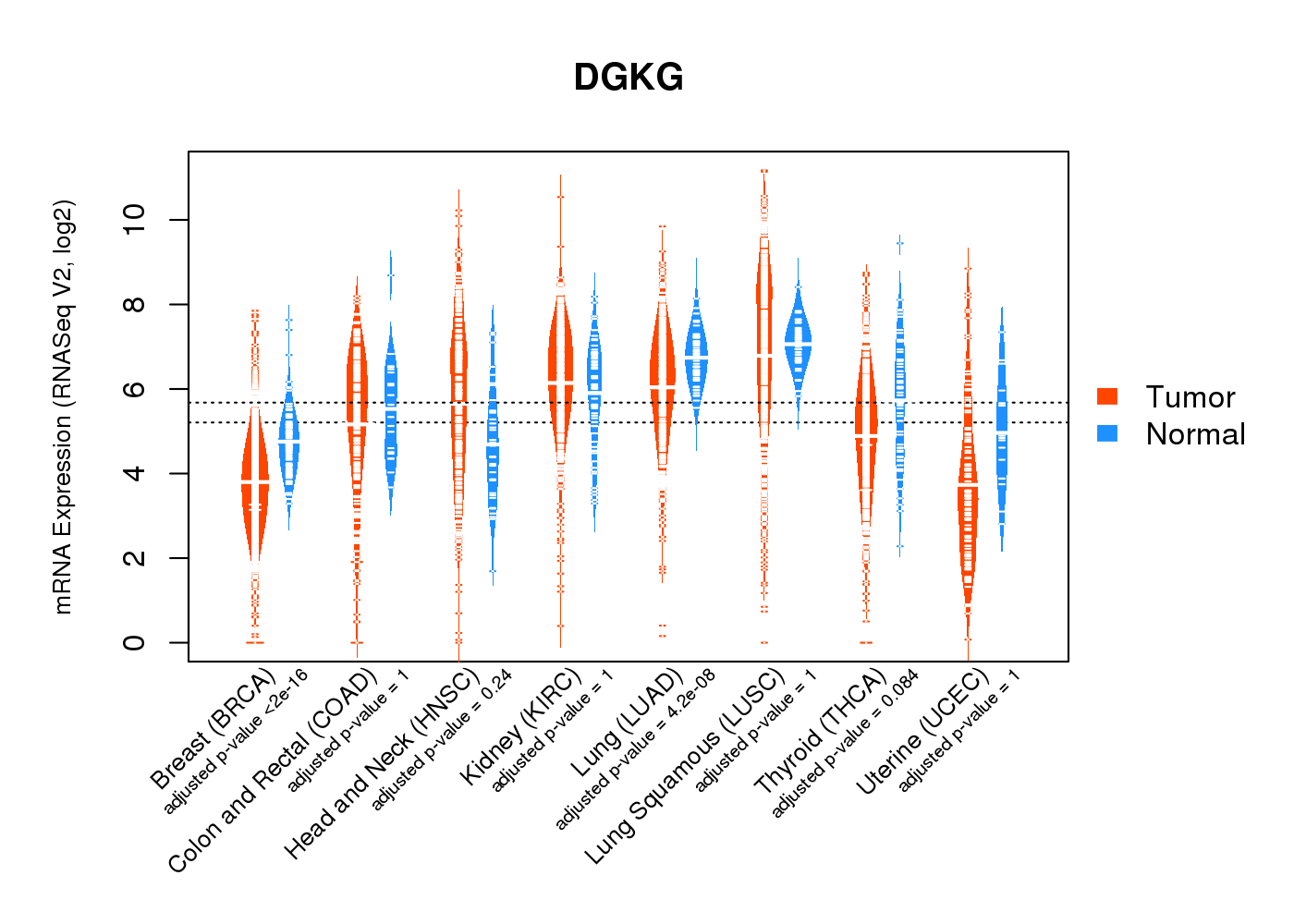 |
| Top |
| * This plots show the correlation between CNV and gene expression. |
: Open all plots for all cancer types
 |
|
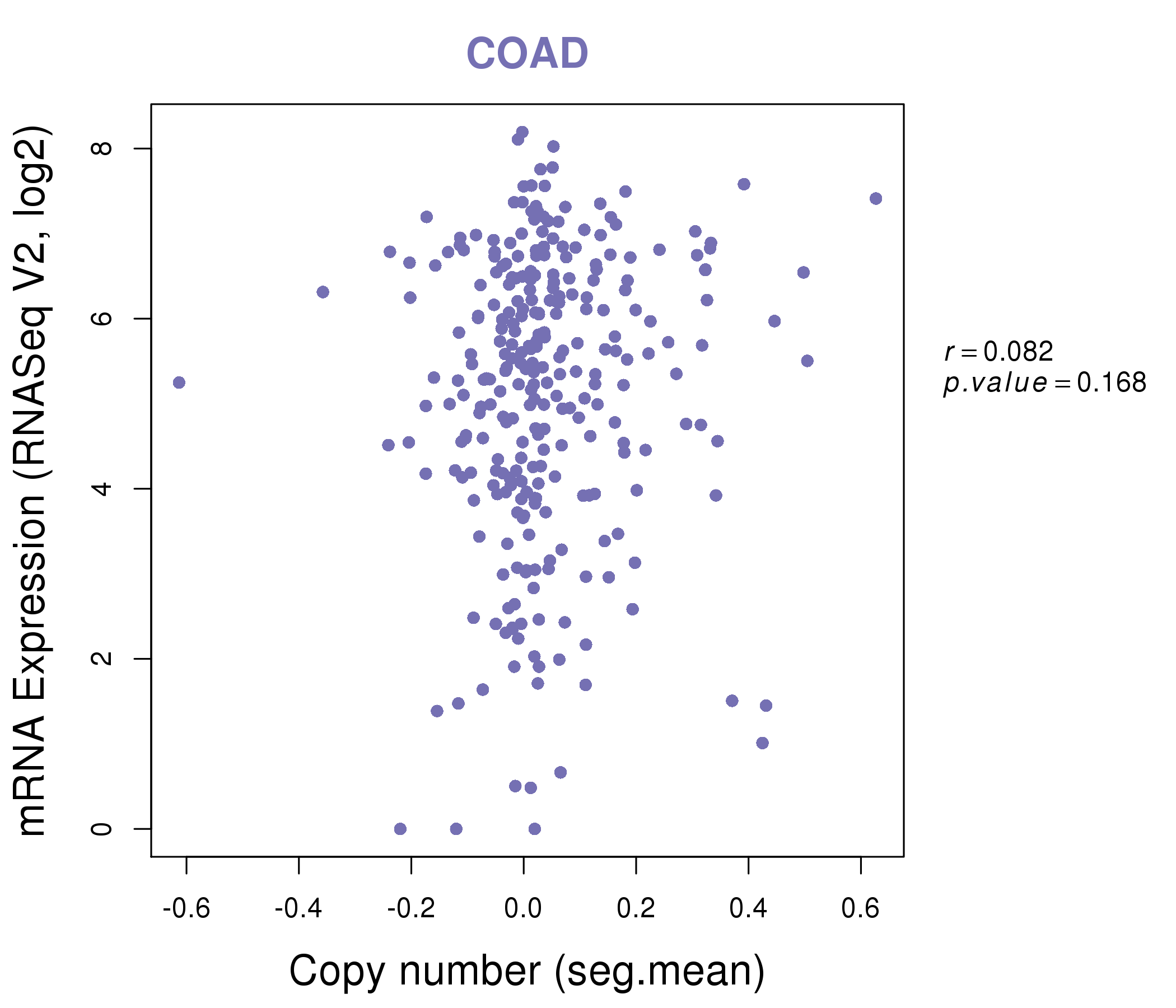 |
|
| Top |
| Gene-Gene Network Information |
| * Co-Expression network figures were drawn using R package igraph. Only the top 20 genes with the highest correlations were shown. Red circle: input gene, orange circle: cell metabolism gene, sky circle: other gene |
: Open all plots for all cancer types
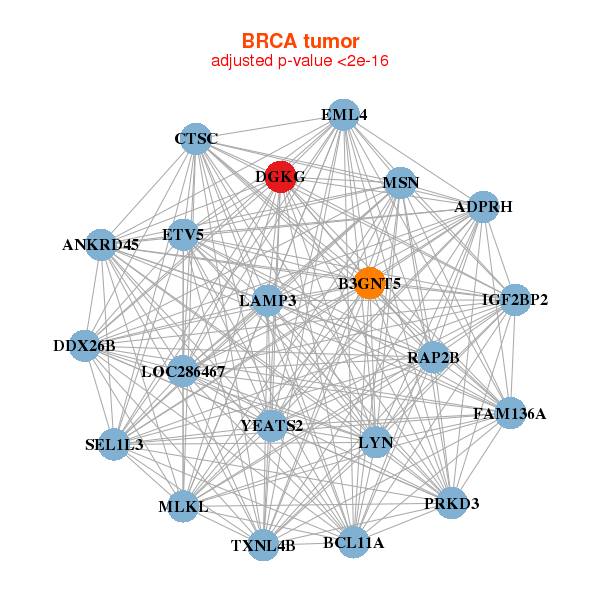 |
| ||||
| ADPRH,ANKRD45,B3GNT5,BCL11A,CTSC,DDX26B,DGKG, EML4,ETV5,FAM136A,IGF2BP2,LAMP3,LOC286467,LYN, MLKL,MSN,PRKD3,RAP2B,SEL1L3,TXNL4B,YEATS2 | ACAN,ALDH1B1,MAP3K7CL,DGKG,FHL5,GPR20,HTR1B, INPP5A,ITGA8,ITIH3,KCNA5,LOC401093,MYOCD,NOV, OR51E2,PDE4C,PPP1R12B,RCAN2,SUSD5,TGM2,TYRP1 | ||||
 |
| ||||
| ABCD1,ACSL4,AIM2,APOBEC3G,CMPK2,DGKG,DYNLT3, ELK1,EMR1,G6PD,HERC6,IFIT2,IFIT3,IFIT5, LAMP3,LOC550643,PJA1,PRKCQ,PRPS1,SLC9A7,SNX10 | ACTG2,BVES,CCDC136,CNN1,CSRP1,CTNNA3,DACT3, DES,DGKG,DMPK,DNAJB5,FAM46B,KCNE1,KCTD8, LDB3,MCAM,PCP4L1,PCYT1B,PDLIM7,REEP2,ST6GALNAC5 |
| * Co-Expression network figures were drawn using R package igraph. Only the top 20 genes with the highest correlations were shown. Red circle: input gene, orange circle: cell metabolism gene, sky circle: other gene |
: Open all plots for all cancer types
| Top |
: Open all interacting genes' information including KEGG pathway for all interacting genes from DAVID
| Top |
| Pharmacological Information for DGKG |
| DB Category | DB Name | DB's ID and Url link |
| Chemistry | ChEMBL | CHEMBL1075157; -. |
| Organism-specific databases | PharmGKB | PA27314; -. |
| Organism-specific databases | CTD | 1608; -. |
| * Gene Centered Interaction Network. |
 |
| * Drug Centered Interaction Network. |
| DrugBank ID | Target Name | Drug Groups | Generic Name | Drug Centered Network | Drug Structure |
| DB00144 | diacylglycerol kinase, gamma 90kDa | approved; nutraceutical | Phosphatidylserine |  |  |
| Top |
| Cross referenced IDs for DGKG |
| * We obtained these cross-references from Uniprot database. It covers 150 different DBs, 18 categories. http://www.uniprot.org/help/cross_references_section |
: Open all cross reference information
|
Copyright © 2016-Present - The Univsersity of Texas Health Science Center at Houston @ |








